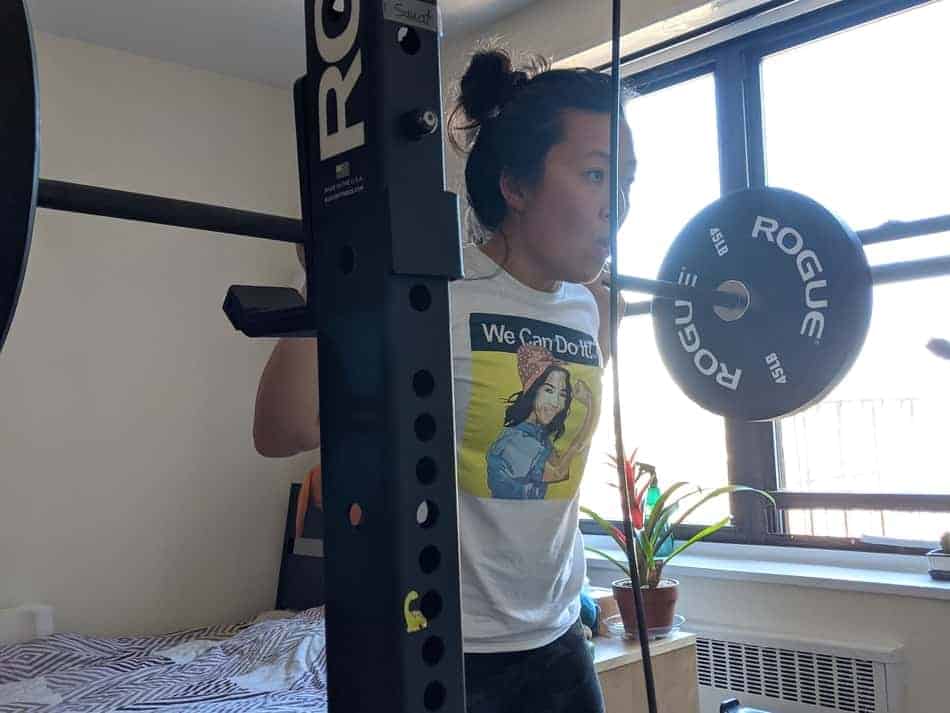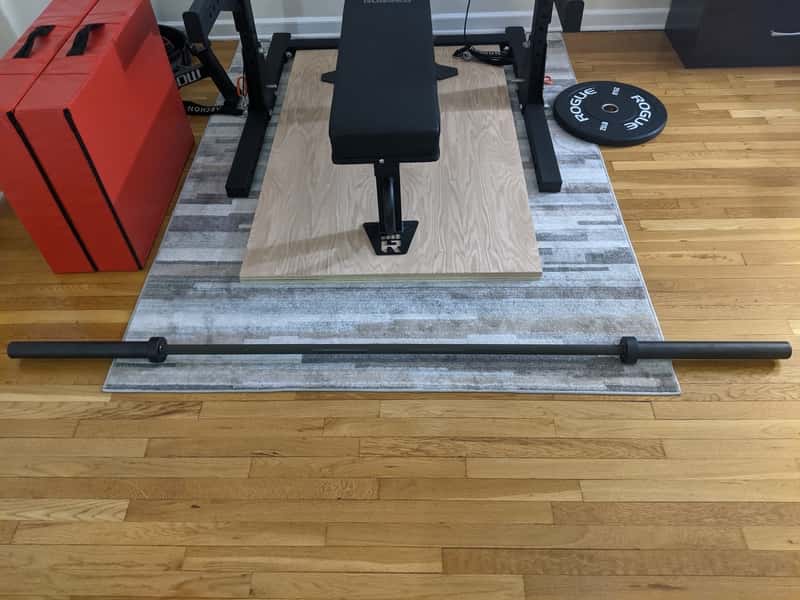This post contains affiliate links.

I first started working out at the gym back in 2014, and the thought of entering a gym with no idea where to start was so daunting. Lucky for me, I had a few friends who graciously went to the gym with me. Here are some lessons that I’ve learned at the gym.
So you want to start working out, but you don’t know where to start? Starting to work out and being consistent is simple when you learn to manage the following.
- Mindset: Overcome your fears and understand what’s important to you
- Education: Become aware of the paths you can take to start training for strength, endurance, and flexibility/mobility.
This is my guide to start exercising at home or in the gym.
Table of Contents
How To Overcome The Fear Of Going To The Gym
The biggest obstacle that stands in the way for beginners is gym phobia! Here are some tips to help overcome the fears of going to the gym for women.
| Anxious Thoughts | Proactive Thoughts |
| “I don’t know where to start.” | “I’m going to explore different types of exercise and training to figure out what I enjoy.” (see below for guidance) |
| “I’m going to have trouble using equipment.” | “I’m going to learn the basics of movements and keep building.” (see below for guidance) |
| “I’m doubting my abilities.” (Imposter syndrome) | “Everyone starts somewhere, and everyone is in the process of learning, even experts.” |
| “I feel like I don’t belong.” | “I belong anywhere that I wish to take up space.” |
| “I feel intimidated by people who are in better shape.” | “I’m going to learn how to appreciate the people around me.” |
| “Others are staring at me.” | “Most people at the gym are focused on their own workouts; it’s very not likely that they’re staring at me. And if they are staring, so what?” |
| “I feel anxiety about sweating.” | “Everyone sweats, and it’s nothing to be ashamed of. Own it.” |
| “I’m unfamiliar with gym etiquette.” | “Gym etiquette is pretty simple. I’ll put everything back where I found it and wipe down equipment after I’ve used it.” |
Learn About Different Types Of Exercise
Strength Training
One of the top fears of the gym revolves around the equipment in the weight room. But it’s far less overwhelming if you understand the use case for each piece of equipment. Let me explain.
There exist various modalities to build strength. Where to start strength train can be determined by your current fitness level and your interests.
You can expect two categories of strength training equipment – weight machines and free weights.
Weight machines (like a smith, lat pull-down, or leg press machine) are exercise machines that isolate a single muscle group but restrict your range of motion to unnatural positions.

Free weights (like a barbell, kettlebell, or dumbbell) allow your joints to move naturally while strengthening major muscle groups and small stabilizing muscles. Because of this, free weights are more effective in building body awareness and balanced strength compared to weight machines. The versatility makes it the preferred option if you’re looking to branch off or supplement another sport.

Okay, here’s a progression that you can follow to build strength with free weights.
| What | Who | Where | Why | |
| 1. Bodyweight | Use your weight for resistance against gravity. | All levels: From a beginner looking to progress towards more difficult movements within bodyweight, resistance band, dumbbell, kettlebell, or barbell training to an experienced athlete working towards calisthenics. | Small spaces (at home or hotel), outdoors | Calisthenics |
| 2. Resistance Bands | Stretch the bands to provide a form of resistance. | All levels: From a beginner looking to progress towards more difficult movements within bodyweight, dumbbell, kettlebell, or barbell training to an experienced athlete working on stabilizer muscles to keep joints safe and healthy. | Small spaces (at home or hotel), outdoors | Functional |
| 3. Dumbbell | A handle with balanced weight on each side. | All levels: From a beginner introduction to free weights to an experienced athlete working on unilateral and stabilization strength to keep joints safe and healthy. | Small spaces (at home) | Functional |
| 4. Kettlebell | An off-centered spherical weight with a handle. | All levels: From a beginner introduction to free weights to an experienced athlete working on unilateral and stabilization strength to keep joints safe and healthy. | Small spaces (at home) | Functional |
| 5. Barbell Training | – Barbell: A long bar used to carry weight. – Barbell plates: Weight in the form of a disc to be combined with barbells. – Squat stand: Upright posts that support the barbell and weights. – Weight bench: A bench with pads. | Must have the ability to lift the barbell at a minimum (typically 45 pounds). | Small spaces (at home) | Sport-specific training |
Lastly, what are steps you can take to start building strength? Millions of training programs exist. Building solid foundations for the big three via Push Pull Legs is a great starting point. Be careful about trying too many things all at once – this could lead to learning nothing. It’s more effective to improve your connection with a few exercises and learn about the mind-body connection.
Endurance Training
Endurance training refers to aerobic exercises like walking, running, cycling, rowing, swimming, or even jumping rope!
It’s simple to start any of these exercises. Just make sure you’re gradually easing yourself into each activity. Learn more about the details in How To Start Running For Beginners. In short, start with low-intensity and increase time and intensity gradually over some weeks or months to let your body adapt. It might be tempting to jump into intense movements, but that’s potentially very dangerous and severely increases your risk of injury.
Flexibility Training
When it comes to flexibility, consistency is key. If you work on your flexibility once in a blue moon, you won’t see much progress. And if you don’t work on it at all, it’s possible to get more stiff over time because you lose what you don’t use.
So here are a few ways you can start working on your flexibility consistently.
- Dedicate specific sessions for flexibility and mobility weekly (yoga), or
- Incorporate shorter stretching sessions every day (stretching)
How Much Exercise Is Recommended?
The CDC recommends adults get at least 150 minutes a week of moderate-intensity aerobic activity and muscle-strengthening activities. If you choose to exercise 5 times a week, that’s about 30 minutes of activity every day.
But would you rather exercise by counting down the time or by focusing on a greater purpose? Here are some results of changing your attitude towards exercising for wins (through focus) rather than time.
| Exercise For Time | Exercise With Focus | Results Of Focus Over Time |
| Just going through the motions. | Be a student, and strive to learn something new. Building body awareness, feeling a better connection, and seeing progress are all small wins that add to big wins. | The shift from passive to active mindset. |
| Time drags on when you’re counting down the time. | Focus on improving something specific to work towards a bigger goal. | Create space for a greater purpose to exercise. |
| If you work for time, it’s not guaranteed that you’ll get anything out of the experience. | If you’re working towards something, you can effectively develop new transferable skills. | Learn new skills from focus, not time. |
Combining strength, endurance, and flexibility/mobility training will improve your overall athleticism so you can do more. How much of each depends on your interests and goals. The secret to sustaining an active lifestyle is enjoying it.
Related Questions
As a beginner, how do I make sure my form is correct? When you first start working out, try not to max out or exercise till failure, even if you can, because it puts you at risk for injury. Practice different cues over some time and record yourself to check your form. Keep in mind that there’s always something new to learn about a technique that works for your body, even when you’re more “experienced.”
HomeStrengthToolbox.com is a participant in the Amazon Services LLC Associates Program, an affiliate advertising program designed to provide a means for sites to earn advertising fees by advertising and linking to Amazon.com. We also participate in other affiliate programs which compensate us for referring traffic at no extra cost to you.
